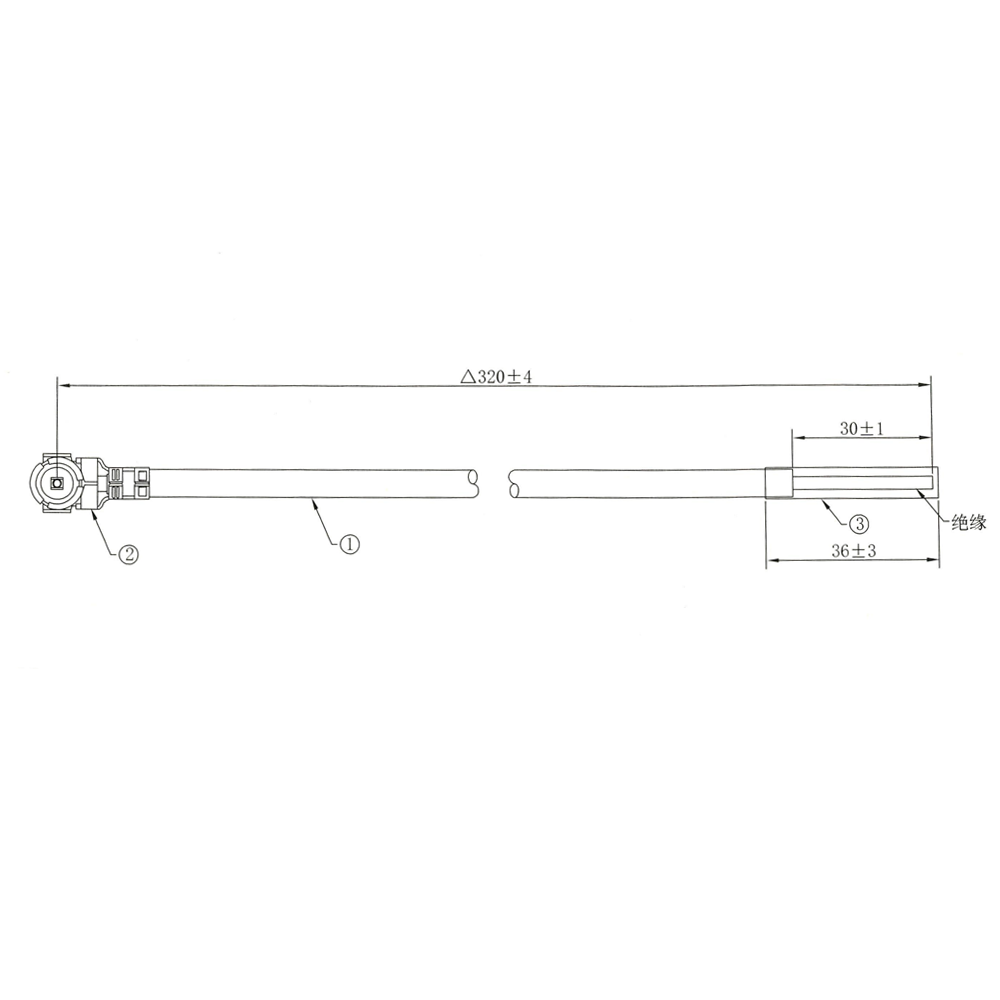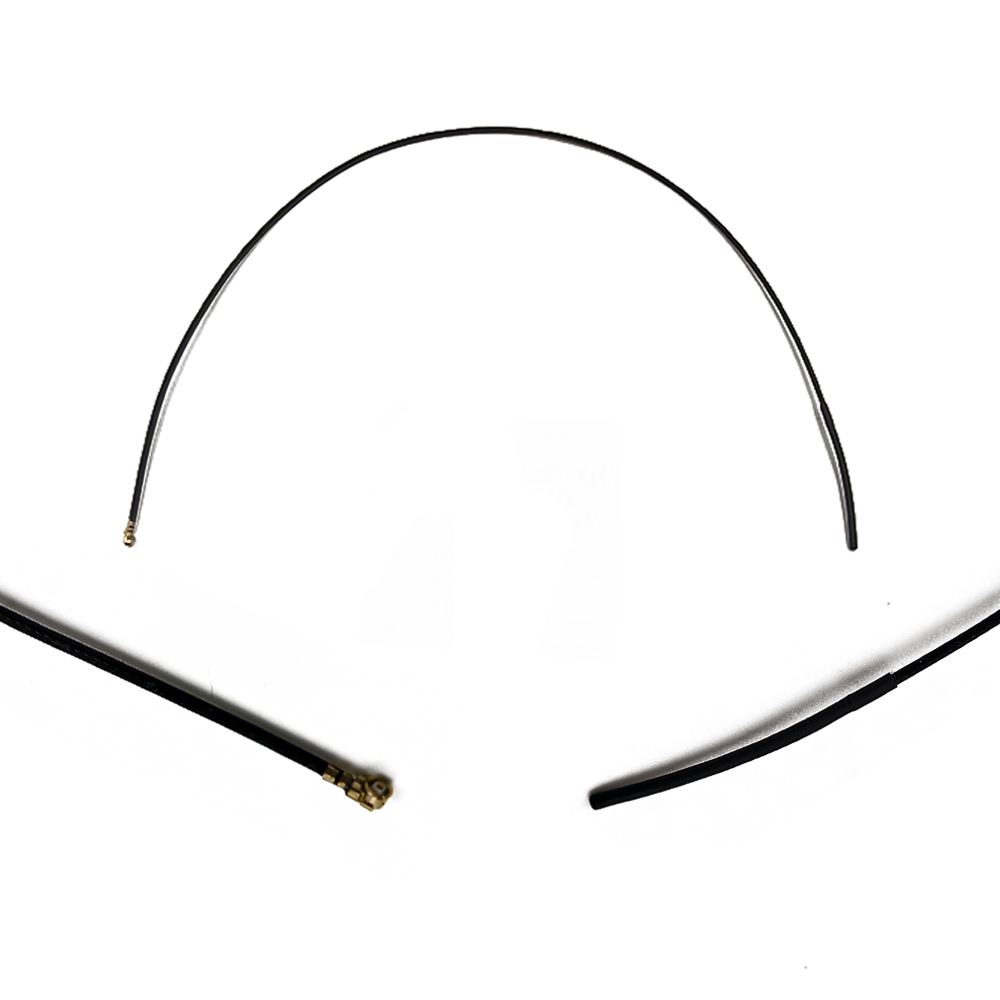fundamental aspect of this antenna’s design
A fundamental aspect of this antenna’s design is its single conductor configuration, a feature that contributes to its compactness and efficiency. Unlike multi-conductor cables, which are bulkier and more complex, a single conductor simplifies the antenna’s structure, reducing its overall size and weight. This design is particularly well-suited for GNSS applications, where the primary function is to transmit and receive high-frequency signals—tasks that can be efficiently handled by a single conductor. The simplicity of a single conductor also minimizes signal loss and interference, as there are fewer pathways for noise to enter the system. For compact devices where space is at a premium, this streamlined design ensures that the antenna can be integrated without compromising the device’s form factor or performance.
The conductor material is tinned copper, a choice that balances conductivity, durability, and cost-effectiveness. Copper is an excellent conductor of electricity, ensuring that GNSS signals are transmitted with minimal loss—a critical factor for weak satellite signals that require precise handling. The tin plating adds a protective layer, preventing corrosion and oxidation that could degrade conductivity over time. This is particularly important for antennas used in humid or harsh environments, where exposure to moisture or chemicals could otherwise damage the copper conductor. Tinned copper also enhances solderability, making it easier to attach the conductor to connectors or PCBs during manufacturing. For compact antennas, where every component must perform reliably in a small space, the combination of copper’s conductivity and tin’s protection ensures long-term performance and consistency.
Notably, the antenna specifies no fiber type, confirming that it relies solely on metallic conductors for signal transmission. This is consistent with GNSS technology, which uses radio frequency (RF) signals that do not require optical fibers. The absence of fiber simplifies the antenna’s design, reducing its complexity and cost while ensuring compatibility with standard RF receivers and modules. This makes the antenna a versatile choice for OEMs and developers working with traditional GNSS hardware, as it can be easily integrated into existing systems without the need for specialized fiber optic components.
The cable length of 320 mm is carefully chosen to balance flexibility and signal integrity. A longer cable would introduce excessive signal loss (attenuation) at GNSS frequencies, while a shorter cable would limit the antenna’s placement options within a device. The 320 mm length provides enough flexibility to route the antenna from its mounting position to the GNSS receiver, which may be located in a different part of the device, without significant signal degradation. This length is particularly useful for compact devices where internal components are densely packed, requiring careful cable routing to avoid interference with other electronics. For example, in a smartwatch, the antenna might be mounted near the watch face, while the receiver is located in the wristband— the 320 mm cable allows for this separation without compromising signal quality.
The cable diameter is specified as 1.37 mm outer diameter (OD), a small size that further contributes to the antenna’s compactness. This thin cable can be easily routed through tight spaces, such as the gaps between circuit boards or the seams of a wearable device, without adding bulk. The small diameter also reduces wind resistance and noise, making the antenna suitable for applications like drones or portable navigation devices where aerodynamics or user comfort are important. Despite its thin profile, the cable is designed to be robust enough to withstand bending and flexing during normal use, ensuring that it does not break or degrade with repeated movement.
With an impedance of 50 Ω, the antenna adheres to the industry standard for RF systems, ensuring compatibility with virtually all GNSS receivers, modules, and other RF components. Impedance matching is critical for maximizing power transfer and minimizing signal reflection, which can cause standing waves and reduce signal strength. A 50 Ω impedance is universally accepted in RF design, making this antenna compatible with off-the-shelf hardware from various manufacturers. This compatibility simplifies integration for OEMs, as they can pair the antenna with their preferred receivers or modules without the need for additional matching networks or adapters. For compact devices, where space and cost are key considerations, this plug-and-play compatibility is a significant advantage.
connector type
The connector type is an IPX (U.FL) connector, a miniature coaxial connector that complements the antenna’s compact design. IPX connectors are among the smallest RF connectors available, measuring just a few millimeters in size, making them ideal for use in tiny devices. The connector features a push-pull locking mechanism that ensures a secure connection while allowing for easy disassembly— a valuable feature during prototyping, testing, or maintenance. IPX connectors are designed to work with thin cables (like the 1.37 mm OD cable used here), further contributing to the antenna’s small form factor. While IPX connectors are not as rugged as larger alternatives like SMA or Fakra, they are well-suited for indoor or protected environments where vibration and physical stress are minimal— conditions typical for compact devices such as wearables, IoT sensors, and handheld navigation tools.
The terminal type is a 1st generation terminal with gold plating, a design that enhances conductivity and reliability. Gold is an excellent conductor and highly resistant to corrosion, ensuring that the terminal maintains a strong electrical connection over time. This is particularly important for compact antennas, where the terminal is often a small, delicate component that can be prone to oxidation. The 1st generation terminal design is a proven, cost-effective solution that balances performance and manufacturability, making it suitable for mass-produced compact devices. The gold plating also improves the terminal’s solderability, ensuring secure attachment to PCBs during manufacturing and reducing the risk of connection failures in the field.
The insulation material is EVA (Ethylene Vinyl Acetate), specified as black, a choice that combines flexibility, durability, and protective properties. EVA is a thermoplastic polymer known for its elasticity, chemical resistance, and low-temperature flexibility— qualities that make it ideal for insulating RF cables. In cold environments, EVA remains flexible, preventing the cable from cracking or becoming brittle, which could expose the conductor and degrade performance. The material is also resistant to moisture, oils, and UV radiation, ensuring that the insulation remains intact even in harsh conditions. The black color provides UV protection, preventing degradation from sunlight exposure— a valuable feature for antennas used in outdoor devices like portable GPS units or drone accessories. For compact antennas, where the insulation must be thin to maintain a small diameter, EVA’s combination of flexibility and protection is essential.
The antenna’s operating temperature range of -20°C to +85°C and storage temperature range of -20°C to +65°C ensure that it can perform reliably in a wide variety of environments. This makes it suitable for use in both indoor and outdoor applications, from consumer electronics stored in climate-controlled homes to industrial sensors deployed in extreme conditions. The materials used in the antenna— including the tinned copper conductor, EVA insulation, and gold-plated terminal— are selected for their thermal stability. For example, EVA remains flexible at -20°C, while the tinned copper conductor maintains its conductivity at +85°C. This temperature resilience ensures that the antenna can be integrated into devices used in diverse climates, from cold northern regions to hot desert environments, without compromising performance.
Shielding is provided by a tinned copper braid, a critical feature for minimizing electromagnetic interference (EMI) and radio frequency interference (RFI) in compact devices. EMI/RFI can originate from other electronic components in the device, such as processors, batteries, or displays, and can corrupt weak GNSS signals, leading to positioning errors or signal loss. The tinned copper braid forms a conductive barrier around the inner conductor, absorbing or reflecting interfering signals and preventing them from reaching the conductor. The tin plating ensures that the braid remains corrosion-resistant, maintaining its shielding effectiveness over time. The braid’s coverage (typically 90% or higher) ensures that even small gaps are minimized, providing robust protection in the crowded electromagnetic environment of compact devices. For applications like smartwatches or IoT sensors, where multiple components are packed into a small space, this shielding is essential for maintaining reliable GNSS performance.
antenna’s commitment
Compliance with RoHS (Restriction of Hazardous Substances) underscores the antenna’s commitment to environmental safety and global regulatory standards. RoHS restricts the use of hazardous materials such as lead, mercury, and cadmium, ensuring that the antenna is safe for both users and the environment. This compliance is particularly important for manufacturers selling devices in global markets, as it allows the antenna to be integrated into products sold in regions with strict environmental regulations, including the European Union, China, and North America. For consumers and businesses, RoHS compliance provides assurance that the product is manufactured responsibly, with minimal impact on health and the environment.
The compact GNSS antenna’s design and specifications make it suitable for a wide range of applications, each leveraging its small size and reliable performance. One key application is wearable technology, including smartwatches, fitness trackers, and navigation bracelets. In these devices, the antenna’s 1.37 mm cable, IPX connector, and single conductor design allow it to be integrated into slim, lightweight form factors without compromising comfort or functionality. The antenna’s ability to receive GNSS signals enables features like location tracking, route mapping, and geofencing, which are increasingly popular in fitness and outdoor wearables.
IoT sensors are another major application, where the antenna provides positioning data for asset tracking, environmental monitoring, and smart city infrastructure. Compact IoT sensors are often deployed in remote or hard-to-reach locations, and the antenna’s small size allows it to be integrated into these sensors without increasing their footprint. The RoHS compliance and temperature resilience make it suitable for long-term outdoor deployment, while the shielding ensures that it can operate alongside other sensors and communication modules without interference.
Drone navigation systems also benefit from this compact antenna, as its small size and lightweight design do not impede the drone’s flight performance. Drones require precise positioning for stable flight and accurate mapping, and the antenna’s 50 Ω impedance and reliable signal transmission ensure that GNSS data is delivered to the drone’s flight controller without delay. The 320 mm cable provides flexibility in mounting the antenna on the drone’s frame, allowing for optimal positioning to receive satellite signals.
Portable navigation devices, such as handheld GPS units and hiking compasses, rely on compact antennas to maintain a slim design while delivering accurate location data. The antenna’s tinned copper conductor and shielding ensure that it can receive signals even in challenging environments, such as dense forests or mountainous terrain, where satellite visibility may be limited. The EVA insulation protects the cable from damage during outdoor use, ensuring durability in rugged conditions.
Automotive infotainment systems are an emerging application, where the antenna can be integrated into compact navigation modules embedded in dashboards or rearview mirrors. The antenna’s IPX connector and small cable allow for easy integration into the vehicle’s electronics, while its temperature resilience ensures that it can operate in the hot and cold conditions typical of automotive environments. The shielding protects against interference from the vehicle’s engine, alternator, and other electronics, ensuring reliable GNSS performance for in-car navigation.
In conclusion
-
In conclusion, the compact GNSS antenna represents a masterclass in miniaturized design, combining a single tinned copper conductor, small cable dimensions, and robust shielding to deliver reliable performance in space-constrained applications. Its IPX connector and 50 Ω impedance ensure compatibility with standard GNSS hardware, while its RoHS compliance and temperature resilience make it suitable for global deployment in diverse environments. From wearables and IoT sensors to drones and portable navigation devices, this antenna meets the demands of modern electronics by proving that small size does not have to come at the expense of performance. As technology continues to shrink, the role of compact GNSS antennas like this will only grow, enabling the next generation of small, powerful devices that rely on precise positioning to deliver innovative functionality.




































































 Language
Language
 En
En Cn
Cn Korean
Korean

 Home >
Home > 






 18665803017 (Macro)
18665803017 (Macro)













